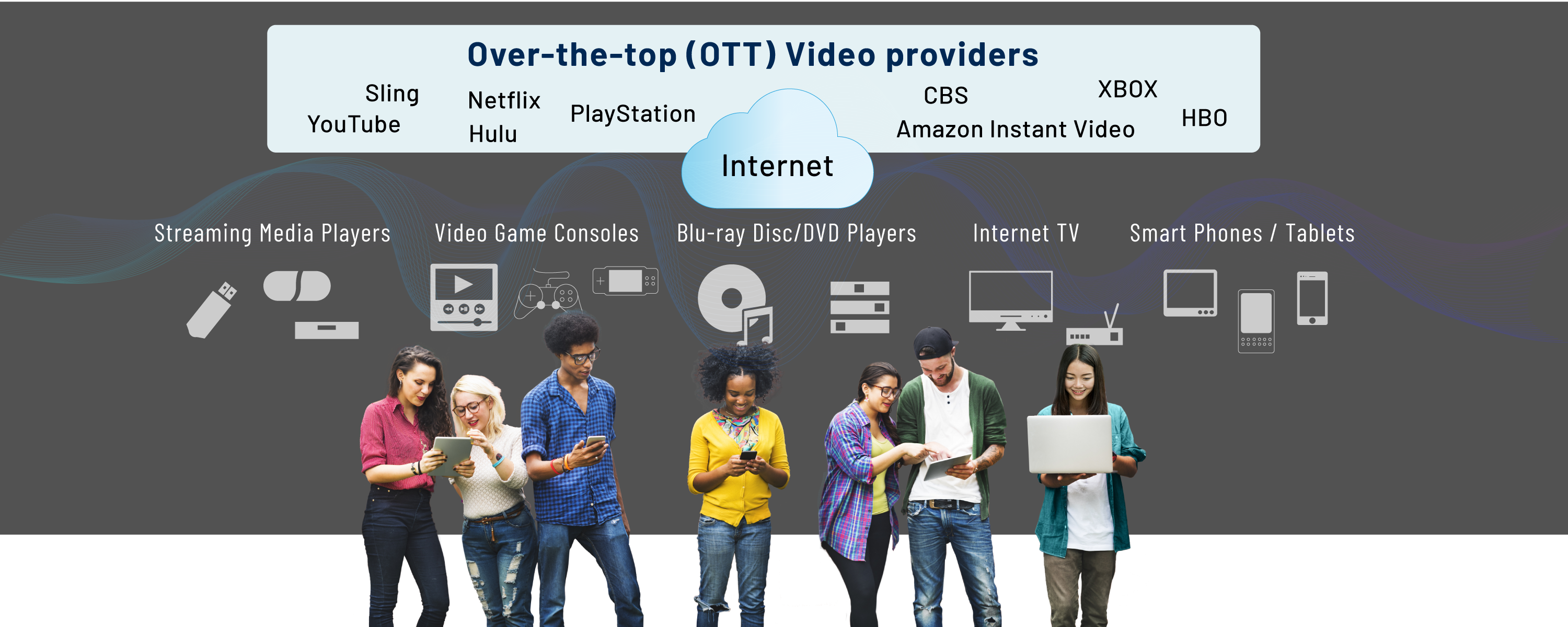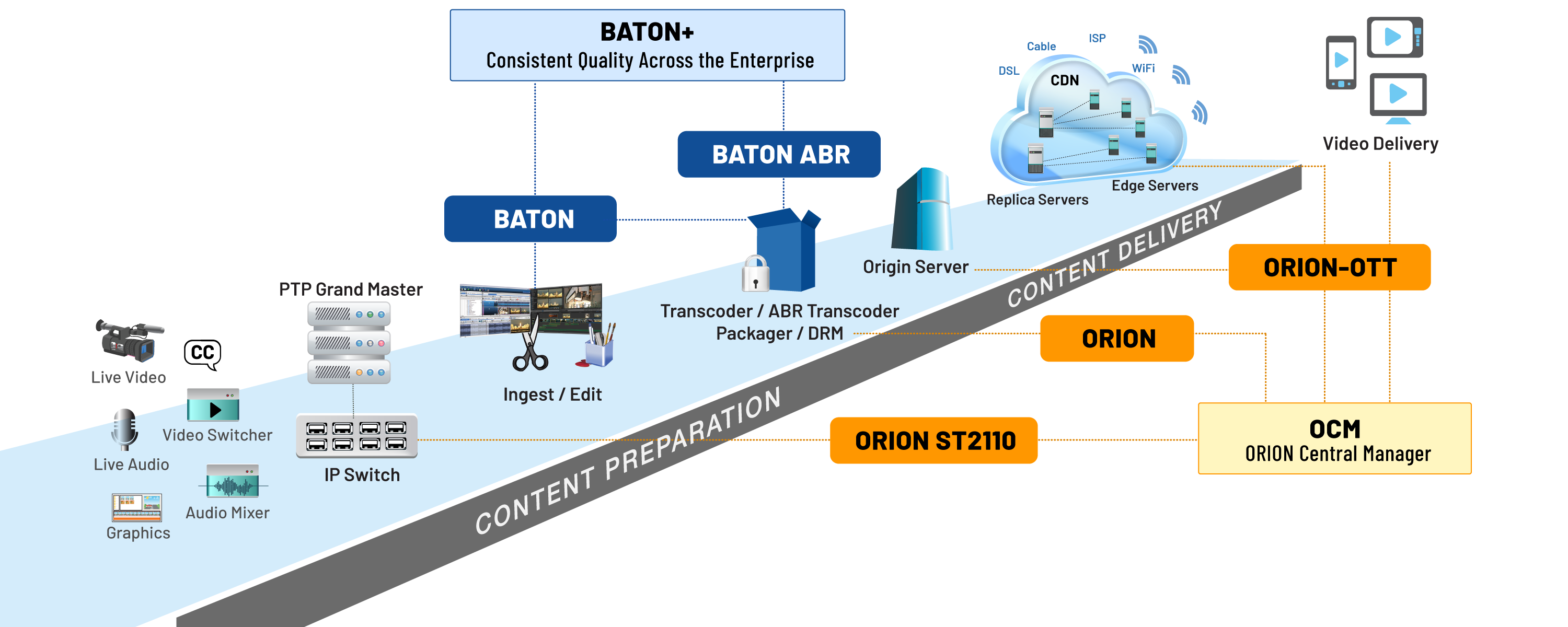Making Content Quality a High Priority: A Guide to Delivering Exceptional QoE and QoS in the Broadcast and OTT Environment
With insights into why end-to-end, AI/ML-based QC and monitoring solutions are imperative today

Introduction
The COVID-19 global health crisis created a surge in video streaming consumption, with a long-lasting impact. Research shows that more than 310 million connected households will have at least one OTT service by 2024, according to Parks Associates. In the U.S., Americans are watching more OTT video than ever before, with about 53% of U.S. households having three or more subscription video on-demand (SVOD) services and 27% have five or more services.
Consumers’ unwavering appetite for content anytime, anywhere and on any screen represents a significant opportunity for service providers. According to Analyses Mason, the total spending on OTT video services worldwide will almost double between 2019 and 2024, from $67 billion to $130 billion.
However, video service providers face immense challenges, as well. The video market, especially streaming, has become very competitive. There is no telling how many video streaming services exist today, but Statistica predicts that by 2026, the number of SVOD subscriptions will reach 1.5 billion.
With so many options to choose from, subscriber loyalty isn’t a guarantee. According to research by Interpret, only 20% of streaming subscribers are content to stay with their current providers.
Given the competitive nature of the video market, it is imperative that service providers deliver high quality. Viewers expect a high QoE on all screens, and a poor video quality of experience (QoE) is a definitive reason why subscribers cancel subscriptions. Research suggests that if there is any buffering or issues with the audio or video, consumers will seek a different service. Yet, delivering an exceptional QoE on every device isn’t easy. The OTT environment is significantly more complex than linear broadcast.
This e-book will explore the challenges of delivering outstanding video-audio quality on every screen, offering guidance on the steps OTT service providers and broadcasters must take to guarantee a high QoE.
Challenges With Distributing High-Quality Video
Offering high-quality video on every screen is critical nowadays, but it is not a simple feat. Let’s take an in-depth look at some of the audio-video delivery challenges service providers are dealing with.
Increased workflow intricacies
OTT is an entirely different world than broadcast. Errors can occur at any point of the workflow, from transcoding to packaging, origin server, and delivery (Fig. 1)

Common issues can include poor video quality caused by over-compression during content preparation, play failures due to unsupported DRM protection schemes on a device, HTTP failures caused by client or server errors, and frequent stalling and switching during playback.
An explosion in content variants
Years ago, broadcasters and video service providers only had to deliver content to the main screen TV. Today, they are distributing content to TVs, smartphones, tablets, and PCs. Each device has a different screen size and supports different formats. Moreover, content is encrypted with different digital rights management protection schemes, (Fig. 2).

The globalization of video offerings adds to the volume of content service providers are managing. Netflix is available in over 190 countries. HBO Max has launched in 60 countries in less than two years, and the company has announced ambitions to eventually stream to 190 countries.
Delivering video content in different countries requires preparing a wide range of different languages, creating audio dubs, and making captions. Maintaining so many different variations of content increases the chance for errors that can impact service quality.
Viewership spikes
Video streaming consumption has been steadily rising in recent years, and the COVID-19 pandemic accelerated the trend. Early in the pandemic, Amazon Prime Video, Netflix, and YouTube were forced to intentionally reduce streaming quality across Europe due to traffic spikes.
Traffic spikes are unpredictable and generally occur when millions of viewers are simultaneously watching a popular event, such as live sports or news, causing a drop in video quality and rebuffering.
The business of streaming live sports is set to see exponential growth in the next few years, with the market increasing from $18.1 billion in 2020 to more than $87.3 billion in 2028. So traffic spikes may continue to be a challenge for video service providers.
Limited control over quality
OTT uses the internet, which is an unmanaged network, to deliver audio-video content to millions of people across the world compared with traditional broadcast delivery, which is over a managed network. With OTT there is minimal or no control over the last mile delivery. Lack of control combined with the fact that multiple stakeholders are involved in the delivery chain (CDNs, ISPs etc.) makes identifying and resolving QoE and QoS issues challenging.
Network infrastructure changes
Beyond the current industry transition from broadcast to OTT delivery, a migration from baseband SDI networks to IP is underway. There are a few reasons for this transformation. Broadcasters are delivering increasingly more bandwidth-intensive content, such as 4K and 8K. SDI cables are simply not equipped to handle the increase in bitrates and data. In addition, SDI networks don’t offer support for remote workflows, which has become essential over the last few years.
As broadcasters operate a mix of SDI and IP networks, they need effective tools for monitoring quality of service and quality of experience.
Targeted ad delivery
In the OTT environment, service providers have an opportunity to send targeted ads to end users, on the fly, using dynamic ad insertion (DAI) technology. But DAI can be difficult to implement in a media streaming workflow. Service providers need a way to check for multiplatform and multiscreen delivery issues, identify the presence of SCTE35 messages in the linear workflow, correct alignment of ads across all profiles/variants, and guarantee the consistency and accuracy of ad insertion.
Five Steps Service Providers and Broadcasters Can Take to Guarantee Outstanding Audio-Video Quality
Considering the extensive challenges that OTT service providers and broadcasters are facing, how do they distribute content with premium quality? Here are five steps they can take to guarantee world-class audio-video quality for broadcast and OTT offerings.
Step 1: Embrace proactive monitoring during content preparation: In the broadcast and OTT environment, errors can occur at point in the workflow, from ingest to post-transcode, post-origin server, CDN, and at the edge. The majority of quality issues occur as a result of improper video encoding during content preparation, necessitating a quality control (QC) system early on at the content preparation stage. The QC system must be able to perform in-depth analysis and quality checks in order to detect any problems that would cause issues with ABR streaming. The best approach is to use an end-to-end QC and monitoring solution that can apply checks at each stage, comprehensively and holistically.
A few of the key checks you’ll want to perform include:
- On the receive side, at ingest, you should do a quick QC and monitoring check for video errors and other quality-related issues—this is important before sending video down for further processing.
- Once ABR streams are created, perform a thorough manifest validation, including content availability, download time, HTTP errors, etc.
- Check to see if every variant adheres to the resolution/bit rate as defined by the organization.
- Assess video quality, especially macroblocking and freeze for each video.
- Assess audio quality for loudness, silence, levels, and more, for each video.
- If pertinent, monitor closed captions and ad insertions.
A comprehensive monitoring methodology during content preparation will help detect the majority of the issues present in the video. When streams are monitored on a continuous basis, quality gaps can be addressed, and processes can be made more efficient. This approach is particularly needed for live, high-profile events, where you don't have the luxury of time to go back and fix errors.
Many video service providers today rely on different systems from different vendors to check content quality and monitor the delivery of video. This can be problematic, as different systems are not designed to communicate with one another. Each system has a completely different user interface, different QoE and QoS measurements, and might interpret results differently, causing inconsistencies and confusion about where the error is taking place. Troubleshooting after the fact is inefficient and ineffective.
With a proactive QC and monitoring strategy, a great number of issues can be detected and resolved before the content is delivered, minimizing issues that happen during content viewing.
Step 2: Consider AI/ML for strategic functions: With AI/ML-based QC technologies, broadcasters and service providers can ensure that the experience they are delivering is of the highest quality, while also ensuring that processing time is kept to a minimum.
AI/ML used within automated QC processes enables broadcasters and service providers to operate faster and more efficiently, bringing increased consistency and reliability to certain media tasks, such as content quality checks, compliance, classification, content categorization, lip sync checks, and more.
Using a fully comprehensive, automated QC system, broadcasters can rapidly check the quality of myriad video and audio formats, as well as check the quality of closed captions and subtitles. As broadcasters expand their reach into new countries, AI/ML-based QC solutions will help them to ensure that content complies with all industry and government regulations and address the various OTT and on-demand delivery ecosystem requirements.
AI/ML technologies, combined with computer vision, play an increasingly crucial role in enabling broadcasters and media providers to generate metadata for content classification purposes. Content classification is important for VOD and OTT delivery, enabling broadcasters to censor certain types of content, identify celebrities, and detect the presence of brands or objects within content. Previously, this kind of analysis would have required human decision making at every level.
In addition to AI/ML auto QC solutions leveraging image processing, this technology and deep neural networks can aid in quick, precise identification of lip sync issues and facial recognition, optimizing the quality of experience for viewers. This is critical, as lip sync issues have long been one of the most noticeable and irritating errors for consumers, and can lead to churn.
The latest AI/ML models, designed for broadcaster and media company use, speed up the identification of such errors across multiple content formats. With automated and AI models for data analytics, broadcasters can gain unique insights into viewing behavior and further enhance QoE.
Finally, good captioning, subtitling, and audio description have become an increasingly key requirement for media content today, and ML is effective at checking for the presence and accuracy of these services.
Step 3: Complement your automated solution with manual review: Auto QC and monitoring solutions address the reality that service providers are handling a much higher volume of content than ever before. Solely relying on traditional visual inspection methods to detect video-audio quality issues is too time-consuming and inconsistent.
Using an automated QC system, broadcasters can speed up the process of checking baseband video and audio quality, as well as the quality of closed captions and subtitles. Auto QC systems also simplify compliance with industry and government regulations, while addressing the wide range of OTT and on-demand delivery ecosystem requirements.
But that doesn’t mean that service providers should abandon manual content review processes. When service providers pair an auto QC and monitoring solution with a manual review process, they can further increase workflow efficiency and improve video-audio quality.
Step 4: Centralize monitoring operations: Centralized monitoring systems help service providers gain insight into service quality at each and every point of the workflow. Having a centralized view of errors, with monitoring probes placed at the encoders, transcoders, origin servers, and CDNs, helps in error isolation and correlation. A centralized monitoring system provides alerts, along with video and audio quality tracking and scoring at any point, for any content. In essence, it offers unprecedented visibility and control over the entire video preparation and delivery chain for live and VOD content.
It’s important to choose a centralized monitoring solution that provides the real-time status of all channels across the network, including linear and OTT offerings.
Having enterprise-wide visibility into QoE and QoS issues across diverse geographies is a must in today’s OTT environment. This approach also allows deployment of a monitoring probe on demand, ensuring service providers are able to deliver premium events and VOD assets to a broader global audience. The flexibility of deploying monitoring probes on-demand is a feature that is unique to cloud-based monitoring solutions.
Step 5: Be cloud ready: The use of cloud technology has become universal in nearly every industry, including video. By monitoring video-audio quality via a software-based solution deployed in the cloud, service can providers to take advantage of newer, faster processors for optimum performance. The cloud-based model eliminates the need to invest heavily in infrastructure. Relying on the expertise of technology service providers to manage installations and provide maintenance, operators can focus on running their business and developing better content.
In general, the dynamic nature of OTT requires scalability, and cloud-based workflows address the need for instant scaling. With a cloud-based architecture, operators can scale up and down storage, media asset management, origin servers, CDN capacity, and other systems in the workflow, based on demand, without impacting performance. The scalability, flexibility, and elasticity of a cloud-based architecture allows OTT service providers to launch new services rapidly from anywhere in the world.
Summary
Competition is fierce in the video world. There are many different video offerings to choose from, and today’s consumers are streaming more content than ever. Expectations about the viewing experience have evolved, and it’s no longer acceptable to deliver lesser quality on secondary devices.
Delivering an exceptional QoE and QoS on every screen is crucial for maintaining subscriber satisfaction, driving customer engagement, and increasing profitability. However, video service providers are swamped by the amount of content they are managing and have limited visibility into their customers’ QoE, making the task incredibly difficult. The migration from SDI to IP has created additional complexity, and new technologies like DAI require extra checks to ensure content is delivered with confidence.
As one of the only technology providers to offer a holistic, end-to-end QC and monitoring solution that is fully automated, Interra Systems is leading the charge for improved audio-video service quality, (Fig. 3).

Interra Systems’ range of solutions work across the entire media workflow, from content preparation to content delivery, and include BATON, BATON Captions, BATON LipSync, BMP-Media Player, ORION, ORION-OTT, ORION 2110 Probe, ORION Central Manager, VEGA Analyzer, VEGA AVSync, VEGA Vista, WINNOW, and Interra Cloud Services.
Our solutions feature centralized monitoring and powerful AI/ML technologies, helping service providers detect and resolve video streaming issues in real time and gain greater insights into what is happening in media workflows, all through a software-based architecture that is deployable in the cloud and on-premises. The result is greater efficiency, better video quality, and increased monetization of broadcast and OTT content.
To learn more about our award-winning solutions visit www.interrasystems.com.
Get the TV Tech Newsletter
The professional video industry's #1 source for news, trends and product and tech information. Sign up below.
Anupama Anantharaman, Vice President, Product Management at Interra Systems, is a seasoned professional in the digital TV industry. Based in Silicon Valley, California, Anupama has more than two decades of experience in video compression, transmission, and OTT streaming. Her journey began as a software engineer at Compression Labs – a trailblazer in MPEG-based digital video – where she contributed significantly to the development of videoconferencing systems. Over the years, Anupama has transitioned into roles encompassing product management and business development, primarily concentrating on internet-based video communications. At Interra Systems, she spearheads the product marketing team, overseeing activities ranging from product definitions and launches to strategic selling and fostering technology alliances. Her focus lies in enhancing video quality control, monitoring, and analyzer products to meet the evolving demands of the media and entertainment industry.

